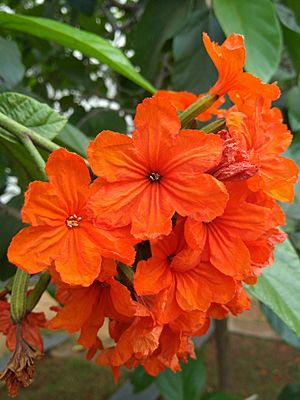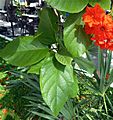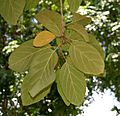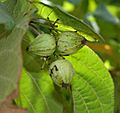Cordia sebestena facts for kids
Quick facts for kids Cordia sebestena |
|
|---|---|
 |
|
| Scarlet cordia flowers | |
| Scientific classification | |
| Genus: |
Cordia
|
| Species: |
sebestena
|
The Scarlet Cordia (scientific name: Cordia sebestena) is a beautiful tree or large shrub. It belongs to the borage family, called Boraginaceae. This plant naturally grows in warm, tropical parts of the Americas. You can find it from southern Florida in the United States and the Bahamas, all the way south through Central America and the Greater Antilles. People call it by different names. In the past, in northern Yucatán, it was known as siricote or kopté (a Mayan word). In Jamaica, it's called scarlet cordia. In Florida, it's often known as the Geiger tree, named after a man named John Geiger from Key West who helped rescue things from shipwrecks.
About the Scarlet Cordia
The Scarlet Cordia can grow quite tall, reaching up to 25–30 feet (about 7.6 to 9 meters) when it's fully grown. It spreads out almost as wide as it is tall. The top part of the tree, called the crown, is usually round or shaped like a vase. Its branches tend to hang down a bit. This tree naturally grows with many trunks, but sometimes it's grown with just one main trunk. A single trunk can become as wide as 12 inches (about 30 centimeters).
This tree has thick, green leaves all year round. They are dark green and feel a bit like leather. The leaves grow in an alternating pattern along the branches. They are oval-shaped and about seven inches (18 centimeters) long, with wavy edges. These leaves have tiny hairs on them, which makes them feel rough, almost like sandpaper.
The Scarlet Cordia produces bright flowers in groups at the ends of its branches. You can see these flowers throughout the year, but especially in spring and summer. Each flower is about two inches (5 centimeters) wide and is a striking red-orange color. They are shaped like tubes that open up into 5 to 7 wide lobes. Inside, they have 5 to 7 parts called stamens, which are all about the same height. After the flowers, the tree grows pear-shaped fruits. These fruits are about two inches long. They smell nice and you can eat them, but they don't have much flavor.
Growing Scarlet Cordia
The Scarlet Cordia is a popular plant to grow in tropical gardens because of its amazing, colorful flowers. It grows slowly. It also drops some leaves and fruits, so it needs a little bit of cleaning up. The wood of this tree is not very heavy, but its branches are strong and don't break easily.
When the tree is young, it's a good idea to trim it. This helps it grow a strong shape, as it tends to grow branches low to the ground. The tree can grow in many different types of soil, as long as the soil drains water well. The Scarlet Cordia can handle dry weather, but it doesn't like cold weather or frost.
This tree usually doesn't get many pests or diseases. However, a specific insect called the geiger tortoise beetle can sometimes eat its leaves. The Scarlet Cordia is also good at handling salty air, which makes it a great choice for planting near the ocean. It loves full sunshine, but it can also grow well if it gets sun for only part of the day.
People use the Scarlet Cordia in many ways. It can be planted along streets, used as a shade tree, or even grown in a pot when it's young. You can often see it planted in the middle sections of roads or in parking lots. It's a very useful tree for coastal areas.
Gallery
-
Leaves, underside (Hyderabad, India)
-
Close-up of flower (Dakar, Senegal)
-
Fruits (Hyderabad, India)
See also
 In Spanish: Vomitel colorado de Cuba para niños
In Spanish: Vomitel colorado de Cuba para niños







